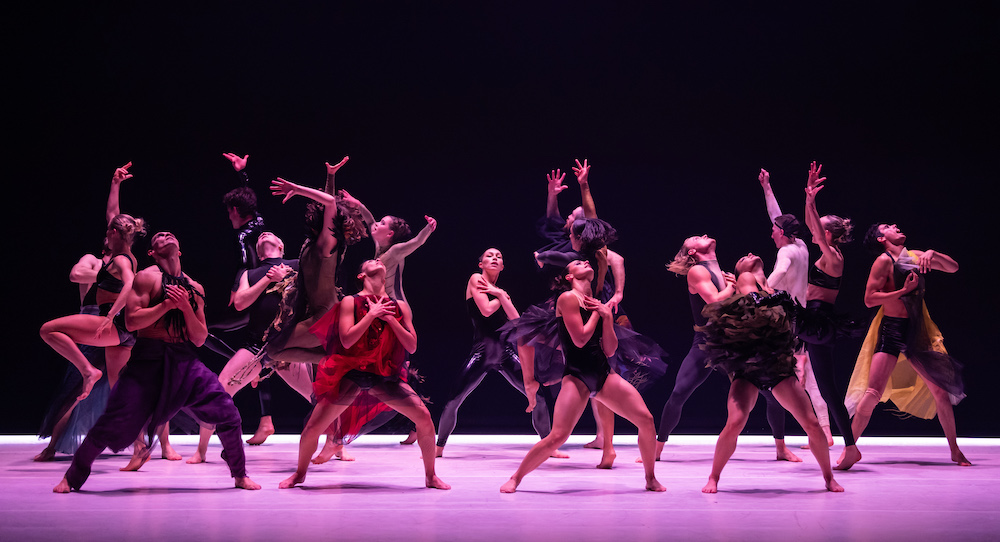Roslyn Packer Theatre, Sydney.
18 September 2024.
Sydney Dance Company presented its second Sydney season for 2024 at the Roslyn Packer Theatre this month with Twofold, a double bill of old and new in Rafael Bonachela’s 2021 work Impermanence making a reappearance, and the world premiere of Melbourne based choreographer Melanie Lane’s Love Lock.
Having opened to rave reviews in its initial 2021 season, Impermanence is no less impressive three years on. A beautiful work with an incredible journey that spans both sides of the pandemic, the work almost making it to a 2020 opening, the COVID-19 lockdown halting that plan. Impermanence gives us a tangible and layered perspective on the transient nature of life, and the vulnerability of seemingly unshakable structures over the past few years that have left us all reeling. It is an exploration of the fleetingness of moments, the various connections that happen in life, none of it being permanent, everything being transitory. The work has a crafted sense of anxiety, with an incredibly paced score (Bryce Dessner), expertly played live on stage by the Australian String Quartet (Dale Barltrop – violin, Francesca Hiew – violin, Chris Cartlidge – viola, Michael Dahlenburg – cello), that is as layered as the choreography.
There are so many interesting moments in Impermanence, and they just keep coming. The group work is exquisite, and the transitions are constant, moving from solo to duet to small group and then whole group, and in multitude variations. It is a satisfying exploration of the whole space. The purity of movement, ever Bonachela’s signature, is liquid, energetic and creative. The transitions within each individual phrase are fascinating, with a flow that just goes on and on. It has an ephemeral quality that clings yet is not quite tangible.
The costumes for Impermanence (Aleisa Jelbart) are made of earthy hues, with simple t-shirt and modal fabrics, using colours inspired by the regenerating Australian bush after the destruction of fire, another event of the past few years that left an indelible impression. The lighting design (Damien Cooper) compliments the work beautifully, giving the impression of the passing of night and day, and at one point near the end there are what looks like snowflakes on the panel that spans across the back of the entire stage space. Both the costumes and lighting build the sense of hope that seeps in at the end of a very intense work, giving expression to the gamut of emotions that were felt during the shared difficult seasons in our recent past.
It was lovely to see certain company members who are not always featured in the Sydney Dance Company repertoire be given the chance to shine. Sophie Jones and Coco Wood were given more major moments in Impermanence, and they excelled as incredibly strong, technical and interesting performers. The entire company excelled in this work, bringing out the strengths of the group stylistically, their aptitude for interesting partnering, and their ability to channel a synergism that emphasized their excellence as a world class company. The standing ovation was well deserved at the closing of this first work in the program.
Melanie Lane’s Love Lock was quite a contrast to the first. Lane comes from a different creative space entirely. Where Impermanence was moving, Love Lock was entertaining. Drawing from mythology, pop culture and a myriad of love songs, these lyrics, and the sometimes-otherworldly experiences that inspired them, became the basis on which Love Lock was born.
The movement within Love Lock was an entirely different vocabulary. Sharp, pulsating, intriguing, trance-like at times, the mythology and pop-culture references were woven throughout. The work started with par cans on extensions, hanging very close to the floor, on a grid-like pattern all over the stage. They rose like a curtain rising after the first moments of vocalisation by the company, and a movement phrase by a solo dancer; however, they did not do much beyond this, and it would have been amazing to see the poles, spaces and lighting potential utilised further. It seemed a lost opportunity for such a large set up in the beginning.
Costumes were the highlight of this work, created by Akira Isogawa. They had a wonderful colour palate, interesting lines and textures, with a variety of materials such as feathers and metals. They were high fashion, art gallery worthy pieces, with excellent movement lines and weight, emphasizing and enhancing the choreographic qualities of Lane’s unique style. The movement and the costumes worked together like a mythological creature born from the most creative minds, and the lighting (Damien Cooper) and original music (Chris Clark) brought the work together with a finesse that combined the whirlpool of elements to form a complete picture.
Lane’s sharp, dark-edged Love Lock seemed jarring after the fluid and moving beauty of Impermanence. It was in some ways difficult to render commitment to something so starkly contrast in so many ways. But herein lies the challenge. This is the world we live in…everything is fleeting, and nothing is fixed.
Twofold was a very interesting programme of work, with two contrasting pieces that showcase the beautiful versatility of this company. A classic but modern contemporary work, and a cutting edge, more independent style work, they complement each other nicely.
Twofold is playing at the Roslyn Packer Theatre, Sydney until 28 September, before heading to Brisbane in October.
By Linda Badger of Dance Informa.

















